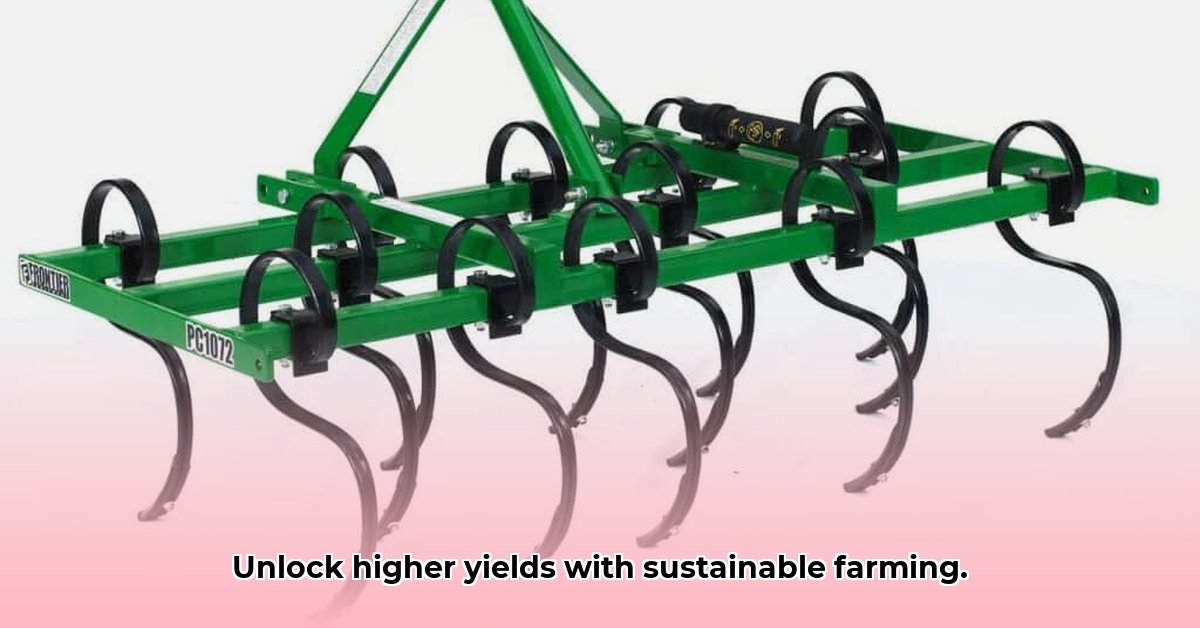
Tractor Cultivators: Your Key to Sustainable and Profitable Farming
Sustainable agriculture isn't just an environmental concern; it's a crucial element of long-term profitability and food security. Conventional tillage methods, while familiar, often lead to soil degradation, reduced water retention, and increased erosion. This comprehensive guide explores how tractor cultivators, used strategically, can revolutionize your farming practices, boosting yields while minimizing environmental impact. We'll examine various tillage methods, analyzing their benefits and drawbacks, and offer a step-by-step plan for implementing sustainable tillage practices on your farm, regardless of scale. For more information on tractor attachments, check out Kioti Attachments.
Tilling the Land: A Comparison of Methods
For decades, conventional tillage, characterized by deep plowing, was the dominant practice. While effective in weed control and seedbed preparation, this aggressive approach severely damages soil structure, leading to increased erosion and nutrient loss. Essential soil organisms are disrupted, diminishing the soil's ability to retain water and nutrients. The high fuel consumption associated with conventional tillage further adds to its environmental cost.
No-till farming offers a stark contrast. This method involves planting directly into the previous year's crop residue, minimizing soil disturbance. This approach protects topsoil, enhances water infiltration, and encourages biodiversity within the soil ecosystem. While initial yields might be slightly lower, long-term benefits often outweigh this slight reduction. However, effective weed management requires careful planning and potentially, the use of herbicides or cover crops.
Precision tillage strikes a balance. Using GPS-guided tractor cultivators, farmers precisely till only the necessary areas, targeting weed patches or fertilizer placement. This targeted approach minimizes soil disruption, maximizing the benefits of both conventional and no-till methods. While the initial investment in technology is higher, the long-term savings in fuel and resources can be substantial.
Don't conventional tillage methods lead to significantly higher short-term yields, offsetting the long-term benefits of no-till and precision methods? (This is a crucial question for many farmers considering a transition.) Studies have shown that while initial yields might be higher with conventional methods, the long-term decline in soil health can lead to lower yields over time.
Tractor Cultivators: The Versatile Tools of Sustainable Farming
Tractor cultivators are versatile implements crucial for all three tillage methods. In conventional tillage, they create a finely prepared seedbed. However, in no-till and precision tillage, their role expands significantly. They become essential for managing weeds, incorporating cover crops (protecting and enriching the soil), and efficiently applying fertilizers, promoting targeted nutrient placement. Effectively, they become indispensable tools for working with the soil, rather than against it.
Weighing the Options: Pros and Cons of Tillage Methods
The optimal tillage method depends heavily on individual circumstances. The following table summarizes the key advantages and disadvantages of each approach:
| Tillage Method | Advantages | Disadvantages |
|---|---|---|
| Conventional Tillage | Good seedbed preparation; initially effective weed control | High soil erosion; poor water infiltration; damages soil structure; high fuel use |
| No-Till Farming | Reduced erosion; improved moisture retention; boosted biodiversity; lower fuel use | Weed challenges; possibly lower initial yields; residue management can be tough |
| Precision Tillage | Targeted soil disturbance; lower fuel costs; efficient resource use; improved water infiltration | Higher upfront investment; needs specialized equipment and expertise; not suitable for all conditions |
A Step-by-Step Guide to Sustainable Tillage
Transitioning to sustainable tillage practices requires a strategic approach:
Soil Assessment: Begin with a professional soil test to understand your soil's texture, nutrient levels, and susceptibility to erosion. This forms the basis of successful tillage planning.
Resource Evaluation: Assess your existing equipment, budget, and labor capacity. This will dictate the feasibility of different tillage methods.
Phased Implementation: Don't overhaul your entire operation immediately. Begin by experimenting with no-till or precision tillage on a small portion of your land and compare the results to your conventional method. This allows for a controlled transition and reduces risk.
Incorporate Cover Crops: Strategic use of cover crops protects soil during fallow periods, improving soil structure and preventing erosion. Tractor cultivators aid in incorporating these cover crops back into the soil, enriching it with nutrients.
Embrace Technology: If your budget allows, explore GPS-guided cultivators for enhanced precision and efficiency. The increased precision minimizes soil disturbance while effectively targeting weeds and fertilizer application.
Continuous Monitoring: Regular monitoring of soil health indicators ensures adjustments are made as needed. Sustainable farming practices are adaptable and require ongoing attention.
"The transition to sustainable tillage requires a shift in mindset – from working against the soil to working with it," says Dr. Emily Carter, Soil Scientist at the University of California, Davis. "The long-term benefits far outweigh the initial challenges."
The Future of Sustainable Tillage
The future of agriculture is inextricably linked to sustainable practices. Ongoing advancements in precision agriculture and cultivator technology promise even more efficient and environmentally friendly methods. This continuous improvement will lead to healthier soils, greater yields, and a more resilient food system for generations to come. Your proactive adoption of sustainable tillage practices is a crucial step in securing this future.